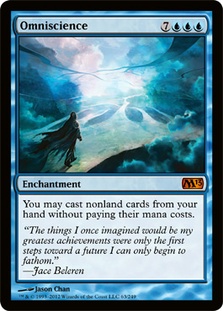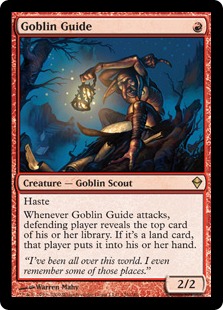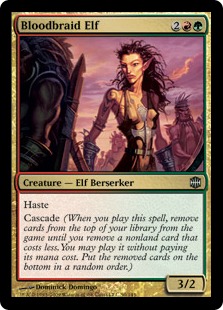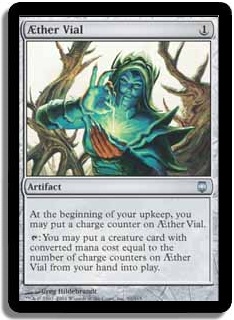With the Magic year coming to a close soon (in terms of block cycles), I’ve decided to go back and figure out what I’ve actually learned. If you are looking for a reason, skip to thought five.
Some of these I’ve known for a while but have never been able to fully articulate. Others are untested, and some are from direct experience. One or more may be wrong, and odds are people won’t agree on which ones those may be.
Thought One: Fifty-Two Blanks, Eight Kill Yous Is Often Enough
Creatures (25)
- 4 Arcbound Ravager
- 4 Ornithopter
- 1 Steel Overseer
- 4 Memnite
- 4 Etched Champion
- 4 Signal Pest
- 4 Vault Skirge
Lands (15)
Spells (20)
Sideboard

“A year ago, I wouldn’t be caught dead playing a deck like this.”
Looking back, I have no idea why this style of deck was outside my range before Tempered Steel. It is very possible that I only assumed it was. I did play Valakut at Nationals just over a year before I made the above statement, but I attributed that more to general dissatisfaction than actually wanting to play the deck.
I often labeled this style of deck as “Magic Online only.” You would win what by any metric would be a great percentage of games, but the losses often felt completely out of your control. I would disqualify these decks for major events because I didn’t want to lose playing for Top 8 without being in the match, but when the sample size was large the variance was acceptable.
I think at some point I just realized the way I thought about mulligans was completely flawed.
I was failing to notice how often I would mulligan hands in general for just being do-nothings. This didn’t happen quite as much as I would aggressively mulligan with Tempered Steel, but it let me level that decision with a “normal” one.
The same applied to the random losses. Every deck is going to have that happen at least once per major event unless you are having a lucky day. It happens. You have to accept that to even begin to think about winning at these events on a regular basis. There should be no difference between this and accepting your deck will crap out once or twice but crush the rest of the time.
I also was using the wrong criteria to mulligan with Tempered Steel. I would mulligan all of the “risky” one landers and keep the four spells, three land hands unquestionably. When you play with one-card wins like Tempered Steel and Cranial Plating, it changes the evaluation from drawing a land to play Magic to drawing a land to win the game. Beyond this making the land light draws be approximately twice as good with these decks, you also had more time to brick on land drops before you would lose to mana screw. On the flip side, your hands lacking the best card were much less likely to win a game. Lands and random spells just wouldn’t cut it.
I also started noticing how often these decks would win off a mulligan or two. Cranial Plating and four blanks is only slightly worse than Cranial Plating and six blanks. Actually, I started noticing how easy it was for any deck to win off a mulligan or two, but when you are trying to trade cards to win it just takes a bit more work.
I’m not sure what defines the specific window these decks are good for, but it isn’t always. They tend to be overly linear, and people will and can adapt. Affinity/Robots in Modern was good up until at least halfway through the PTQ season and apparently is again now. Tempered Steel was very good until at least Dark Ascension, at which point it may or may not have been good for a long time going forward. If you play a deck like this, be prepared to switch once people change their decks. That said, people suck at evaluating how much hate they need. Odds are that will take them a while to figure out beyond them even starting to prepare. Know what the knee jerk reaction is, and know when the deck stops being good.
These rules also apply to other combo decks. See Splinter Twin and Reanimator.
Aside One: People need to stop tilting about mulligans so much. See above. If anything, the lack of perfect focus hurts you even more on the mulligan as you have to play much tighter to make up the disadvantage. The odds of losing when tilted off mulligans are higher than if you assumed tilting and mulligans independently affected your odds of winning.
Aside Two: Modern Affinity is really good right now. I falsely assumed the deck lost to Tron, which I’ve since discovered is a fairly easy matchup. The only change I would make from the Grand Prix winning list is swapping out Ethersworn Canonists for Grafdigger’s Cages. The card covers Goryo’s Vengeance and Pod on top of shutting off Past in Flames from Storm. If they can’t flash back everything, Storm has real issues killing you before they die to Cranial Plating.
Aside Three: Playing these kinds of decks for six months straight has definitely altered my mulligans elsewhere. I’ll get back to you on if this is a good or bad thing, but until then I’ll continue keeping my low land count hands in Limited.
Thought Two: Tournaments Are the Best Testing For Tournaments
One of the greatest fears people have in testing for major events, especially Pro Tours, is that their testing gets inbred. You show up and all the decks you tested look nothing like the ones you were expecting to show up. Your carefully made deckbuilding decisions are way off, and you have Doom Blades in a room full of Zombies (or similar). There are a lot of preexisting methods to avoid this. Don’t battle brews against brews, test with others who might have different ideas, etc.
The issue is that the standard N-game set playtesting is inherently inbred.
Even if you manage to record your evaluations for each set perfectly independently of order before making changes (unlikely) and have the results of each set be unbiased by experience or desire to win (more unlikely), you are still forgetting one huge part of the event: the random factor.
Not everyone will show up playing a big three deck. Not even at a Pro Tour. In fact, I would wager at least 20% of your matches will be against something you have no experience against if you test this way. You need some spread to your deck, not just a honed list with maindeck mirror hate.
Mock tournaments help splice this random factor into the testing. With a large enough group you can also get a full metagame with everyone playing a deck they wish to play, eliminating any bias because a deck’s pilot dislikes what they are playing. With decks locked in and pairings being random, you minimize any bias from matchup ordering affecting card evaluations and help balance out skill mismatches. You even help reduce time wasted by people retesting the same matchup because of mid-event chatter sharing results more effectively.
You also get sideboarding data. This isn’t even just about figuring out which cards are good. Sideboarding gives you the ability to make mistakes in card evaluation. Think a card is bad in a matchup? See what it’s like without it right then. No waiting, no bleed over between matchups.
The main drawbacks to testing tournament style are time expenditure and needing people to battle with. The main issue is that these are not usually available at the same time. Gathering people together ahead of a major event gets difficult until the point you are on site, at which point time is running out. Plan ahead accordingly.
This isn’t to say set testing is a bad thing, but just it alone is not enough. You obviously want some amount of targeted testing, and it works wonders for certain formats. Just consider that there are other options. The amount learned from playing in one PTQ is huge for the remainder of the season, and there’s no reason that shouldn’t be replicated for tournaments without official events beforehand.
Aside Three: Be sure to provide appropriate incentives for winning while making sure people aren’t punished for playing brews. Also try to follow some event rules, especially as the actual tournament approaches.
Aside Four: There’s another old story from Michigan Magic loosely associated with this. A player repeatedly lost in the Top 4 of Pro Tour Qualifiers, always falling slightly short. He realized one day that he would always split the Top 4 of local events and head home. He stopped splitting, started winning, and casually spiked his next PTQ. I don’t know how much this actually matters, but the real moral is that your play habits do matter. Tournament style practice helps.
Aside Five: I’m willing to guess that because of this Cedric Phillips and Michael Jacob Stream Team will do very well at this upcoming Pro Tour. They have a ton of time to practice with 24/7 access to this kind of testing, minus downtime. Barring a huge shakeup from Return to Ravnica, they should be miles ahead. Other potential bonuses: having PTQed in the format this past year.
Thought Three: Real Life Drafting Is Way Better Than Magic Online Drafting
The new in thing is to complain about how 3-vs-3 drafts aren’t representative of eight-man drafts. While that may be right, there is a tradeoff between team drafts and Magic Online 8-4s.
First, single elimination draft structure does not properly evaluate draft skills for high-level events. In a Grand Prix or Pro Tour, half the people who would be eliminated in round two of a draft end up with the same record as the person that loses in the “finals.” Plenty of solid 2-1 decks fail to prize in an 8-4.
Even if you play Swiss, you are losing data by Magic Online drafting. Through three rounds, you see three rounds of data. In a real eight-man, you see three rounds of data per player. Want to know how an archetype works out? Why spend three hours on it when you could just ask the person two seats down.
As with the above section on tournament style testing, six or eight people aren’t always available. This is a legitimate reason to not draft with physical cards. There is also time associated with gathering people, which tends to vary greatly depending on participants/location/hunger. Plan ahead.
Thought Four: When I Evaluate a New Card Replacing an Old One, I’m Likely Wrong
This last portion is more of me putting this down in writing for myself (see: “Creating A Fearless Magical Inventory”), but there are likely others with the same issue.
Let’s take a look at some examples.
Omniscience
I called that this was a strictly worse Dream Halls in Legacy. I missed that not needing an extra card to combo is huge against Esper Stoneblade. I missed that seven Show and Tells (with Burning Wish) and eight monsters is a more reliable combo than having four Dream Halls plus four Conflux with four Show and Tell and four Progenitus. Oops. I’m still unsure which is better, but there’s more of an argument for Omniscience then I had thought.
Griselbrand
I figured this card wouldn’t be much better than other monsters to Show and Tell and was a worse Yawgmoth’s Bargain than Ad Nauseam. The latter was true; the former not so much.
Drogskol Captain
Creatures (15)
Lands (22)
Spells (23)

This list existed a week before Pro Tour Dark Ascension. I did zero testing with it because of the “terrible” mana curve. Oops.
These are just a few publicly recorded examples of this over the past year. The short answer: try first, evaluate later. I generally have a decent head for unique effect, but in the future I just need to sit down and build with four of a new card to try it out before going back to the old shells.
The next time I review anything in a set and say something like, “Card A is just a worse card B,” someone yell at me unless it is blatantly true (e.g., “Don’t play Runeclaw Bears when Timberpack Wolves is in the format”).
Thought Five: Keep Things in Writing
It’s easy to forget or misremember ideas. It’s a lot harder to accidentally alter or lose digital or physical recordings of them.
Aside Six: Despite how many times Pokemon should have taught me to save often, forgetting to do so is still not impossible.
Your disagreements and amendments on these are greatly appreciated.
More on Last Week’s Topic:
The overall message most people took away was that everything that occurs in Magic is conditional to its surroundings. That wasn’t my goal, but it is a better takeaway than the “Look at this cool thing and think about it” I was aiming for…
As for my opinion on the cards I left unlisted at the end, see below.
Goblin Guide
I’m still floored this card exists. It’s a one-mana 2/2 with two upsides: haste and Telepathy. The red decks averaged 20% more likely to win when they had this card in their opening hands. Despite all this, it is still completely reprintable. There is exactly one deck it is good in, and that deck is easily constrained by the quality of burn in the format and the number of direct hate cards that exist for it. Red is a perfectly fine archetype to have exist, and it needs powerful tools in order to do so. Just be sure to keep around one-mana answers for it (last line courtesy of the feedback from last week).
Aside Seven: Contrary to popular belief, Mono Red does still exist in Standard. It just has to play a card that costs BBB.
Future Sight Pacts
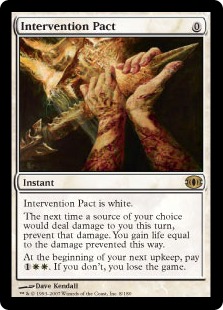
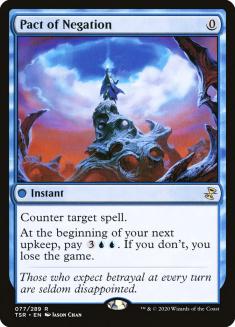
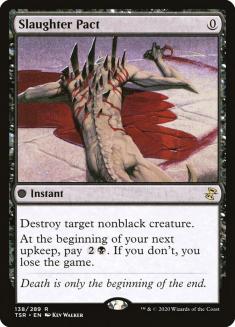
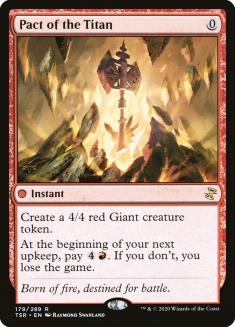
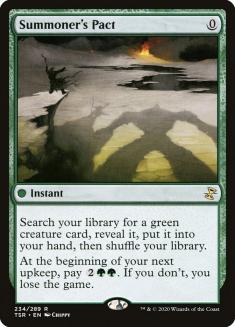
None of these cards is overpowered, but they have unintended effects on board complexity that shouldn’t exist. They are similar to all the talk about how the free activated abilities in Lorwyn made board states almost impossible to read, only on the trick level. The consequence on missing the upkeep trigger also feels off with the new trigger rules and in general leads to negative experiences with forgetting it. They aren’t too good, but I don’t think they make the game better by existing.
Bloodbraid Elf
I still maintain that most of the issue with this card had to do with the surrounding environment. You had a ton of Jund cards that were also undercosted, so cascade would generate a card and three or four mana worth of value. You also had a format with few one-drops and lands that promoted not playing them, allowing you to maximize cascade with little punishment. In a less powerful format I can see Elf being perfectly reasonable. The issue would mostly be in finding a way to get a gold card with cascade into that format. Same issue was Kitchen Finks, only with more layers.
Aether Vial
My instinct is that the mana denial elements and critical mass of power low-drops that make this card a force in other formats would not exist in a Standard format. The main concern would be that this card could be used with fixing to bridge a too many color aggro deck together. Barring that, it seems perfectly fair.
Blood Moon
This card hits nonbasics in a bad way for Standard. I’m unconvinced a mono-color based metagame is healthy, meaning nonbasics for fixing are a must. Punishing people for trying to play normal Magic is not good; hating on people just trying to play two colors falls into this category. If the fixing nonbasics are mostly immune to this card (i.e., fetches), it might be deserved if something like Vivid lands also exist, but that is a huge maybe.

